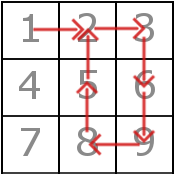题目
There is a matrix A of size x × y filled with integers. For every  ,
, Ai, j = y(i − 1) + j. Obviously, every integer from [1..xy] occurs exactly once in this matrix.
Ai, j = y(i − 1) + j. Obviously, every integer from [1..xy] occurs exactly once in this matrix.
You have traversed some path in this matrix. Your path can be described as a sequence of visited cells a1,a2,...,an denoting that you started in the cell containing the number a1, then moved to the cell with the number a2, and so on.
From the cell located in i-th line and
- (i + 1, j) — only if i < x;
- (i, j + 1) — only if j < y;
- (i − 1, j) — only if i > 1;
- (i, j − 1) — only if j > 1.
Notice that making a move requires you to go to an adjacent cell. It is not allowed to stay in the same cell. You don’t know x and y exactly, but you have to find any possible values for these numbers such that you could start in the cell containing the integer a1, then move to the cell containing a2 (in one step), then move to the cell containing a3 (also in one step) and so on. Can you choose x and
Input
The first line contains one integer number n
The second line contains n integers a1,a2,...,an (1 ≤ ai ≤ 109) — the integers in the cells on your path.
Output
If all possible values of x and y such that 1 ≤ x, y ≤ 109 contradict with the information about your path, print NO.
Otherwise, print YES in the first line, and in the second line print the values x and y such that your path was possible with such number of lines and columns in the matrix. Remember that they must be positive integers not exceeding 109.
Examples
| Input |
|---|
| 8 1 2 3 6 9 8 5 2 |
| Output |
| YES 3 3 |
| Input |
|---|
| 6 1 2 1 2 5 3 |
| Output |
| NO |
| Input |
|---|
| 2 1 10 |
| Output |
| YES 4 9 |
Note
The matrix and the path on it in the first test looks like this:

Also there exist multiple correct answers for both the first and the third examples.
分析
【题意】
给一个只含1~n的路径,选择长宽按照1~n顺序排列的方式生成一个地图,使得路径合法。
【分析】
- 对于一个图而言,宽度w定了以后,所有的点的位置就确定了,而长度只影响取值的范围。所以我们不关心长度,只关心宽度
w 。 - 在一个宽度为w的图上移动,上下走的跨度也是
w ,而左右走的跨度永远是1,所以对于合法的路径而言,相邻的两个点的差不是1 ,就是w。所以我们只关心它的跨度w 。
判断某条路径合法,首先应该满足上面第二条基本性质,才有可能找到一个地图吧——一旦某两个点的差是一个大于1的数,说明它向上/下走了,也就间接限制了地图的宽度只能是这么多,那么反过来,地图的宽度也限制了向上/下走的跨度只能是这么多。所以一个合法路径只能有一个跨度。
在路径的跨度也就是地图的
【注意】
如果两个点是上下关系,它们相差w就一定相邻,反之就一定不相邻,相差
如果两个点是左右关系,它们相差1并不能决定是否相邻,需要对它们的行列关系进行具体判断。
与其对两个点做很多的判断,我觉得不如把从一个点出发会到达的四种可能算出来,然后看其中有没有路径上的下一个点。
代码
#include<stdio.h>
#define max(a,b) ((a)>(b)?(a):(b))
#define min(a,b) ((a)<(b)?(a):(b))
#define mabs(x) ((x)>0?(x):(0-(x)))
#define N_max 200005
int arr[N_max];
int w=1;
int next[4];//0~3代表向上下左右行走会到哪里,-1表示不能走
void cal(int v, int w) {
int x = v / w;
int y = v%w;
//上下好计算
next[0] = ((v - w) > 0 ? v - w : -1);//考虑上边界
next[1] = (v + w);
next[2] = ((v - 1)>0 ? v - 1 : -1);//考虑左边界
next[3] = v + 1;
//左右需特判
if (y== 0)
next[3] = -1;
else if (y == 1)
next[2] = -1;
}
int main() {
int n;
scanf("%d", &n);
for (int i = 0; i < n; i++)
scanf("%d", &arr[i]);
for (int i = 1; i < n; ++i)
{
if (mabs(arr[i] - arr[i - 1]) > w) {
if (w > 1) {
printf("NO"); return 0;
}
w = mabs(arr[i] - arr[i - 1]);
}
}
int flag = 0;
for (int i = 1; i < n; ++i) {
flag = 0;
cal(arr[i-1],w);
for (int t = 0; t < 4; ++t)if (next[t] == arr[i])flag = 1;
if (flag == 0) {
printf("NO");
return 0;
}
}
printf("YES\n1000000000 %d",w);
}总结
当直接判断两个点的关系是否正确很繁琐时,不妨考虑从一个点生成所有可能转移到的点,再检查这个集合是不是含有另一个点。







 本文介绍了一种算法,用于验证给定路径在特定矩阵中的合法性。该矩阵由整数组成,且每个整数在矩阵中唯一出现一次。通过分析路径中相邻整数之间的差异,可以推断出矩阵的可能宽度,并进一步验证整个路径是否符合该宽度的矩阵结构。
本文介绍了一种算法,用于验证给定路径在特定矩阵中的合法性。该矩阵由整数组成,且每个整数在矩阵中唯一出现一次。通过分析路径中相邻整数之间的差异,可以推断出矩阵的可能宽度,并进一步验证整个路径是否符合该宽度的矩阵结构。
















 1149
1149

 被折叠的 条评论
为什么被折叠?
被折叠的 条评论
为什么被折叠?








